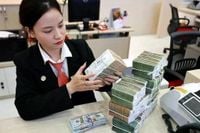On April 4, 2025, the State Bank of Vietnam set the daily reference exchange rate for the US dollar at 24,886 VND/USD, marking a significant increase of 32 VND from the previous day. This adjustment reflects ongoing fluctuations in the currency market as the dollar continues to navigate a challenging global landscape.
As per the current trading band of +/- 5%, the ceiling rate applicable for commercial banks during the day is 26,130 VND/USD, while the floor rate is set at 23,642 VND/USD. This framework allows for some flexibility in the rates that banks can offer, which is crucial for maintaining stability in the foreign exchange market.
At major commercial banks, the opening-hour rates also saw an uptick. At 8:30 AM on April 4, Vietcombank listed the buying rate at 25,610 VND/USD and the selling rate at 25,970 VND/USD, both reflecting a rise of 40 VND from the morning of April 3. Similarly, BIDV raised its rates by 50 VND, with the buying rate at 25,590 VND/USD and the selling rate at 25,950 VND/USD.
In a broader context, the dollar's performance against the Vietnamese dong has shown a notable increase of 1.68% since the beginning of the year. This trend is indicative of the dollar's relative strength in the Vietnamese market, despite challenges on the global front.
Globally, the U.S. dollar has been struggling to regain its footing, particularly as the safe-haven yen hovers near a six-month peak. Traders are closely monitoring the fallout from President Donald Trump's aggressive tariff measures, which have raised concerns about potential economic repercussions. According to a report by Reuters, the dollar was steady after bouncing off six-month lows against both the euro and sterling, with attention now shifting to a crucial monthly U.S. payrolls report that could provide insights into the health of the economy and the outlook for monetary easing.
On April 3, 2025, the dollar index, which measures the currency against a basket of six major peers, experienced a dramatic plunge of 1.9%, marking its worst day since November 2022. This decline reflects the volatility in the currency markets and the challenges faced by the dollar amid shifting economic conditions.
In early trading on April 4, the dollar edged down 0.15% to 145.89 yen, following a session where it slumped 2.2% and dipped as low as 145.19 yen, the lowest point since October 2, 2024. The fluctuations in the dollar's value against the yen further illustrate the ongoing uncertainty in the global financial landscape.
As the dollar continues to navigate these turbulent waters, the implications for both domestic and international markets remain significant. The adjustments made by the State Bank of Vietnam and commercial banks reflect a responsive strategy to maintain stability while adapting to global currency trends.
In summary, the recent movements in the exchange rate and the broader performance of the U.S. dollar highlight the interconnectedness of local and global financial markets. With ongoing economic developments and policy decisions looming, stakeholders are advised to stay informed and prepared for potential shifts in the currency landscape.





